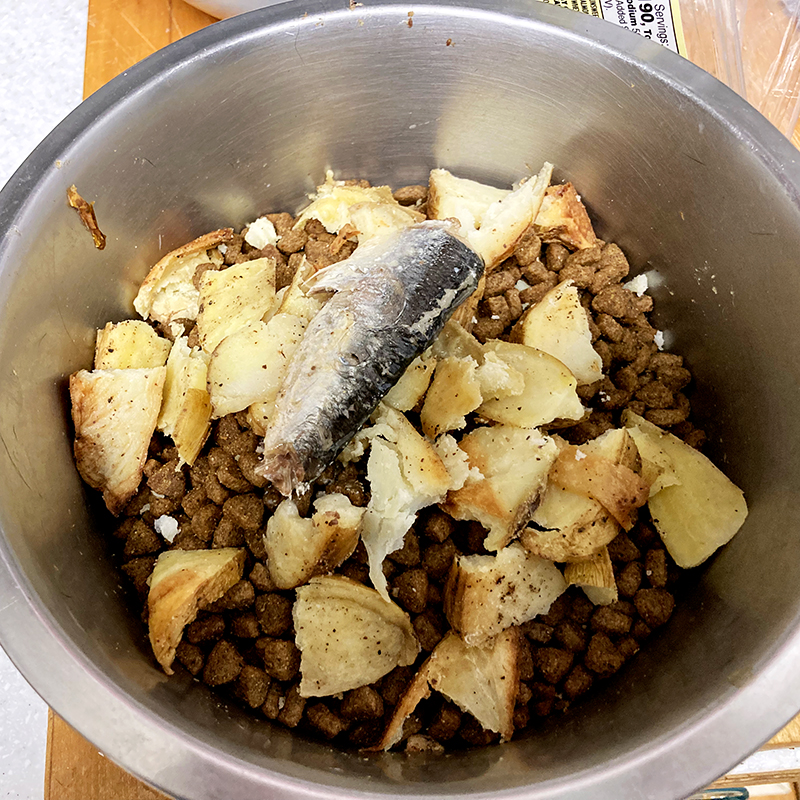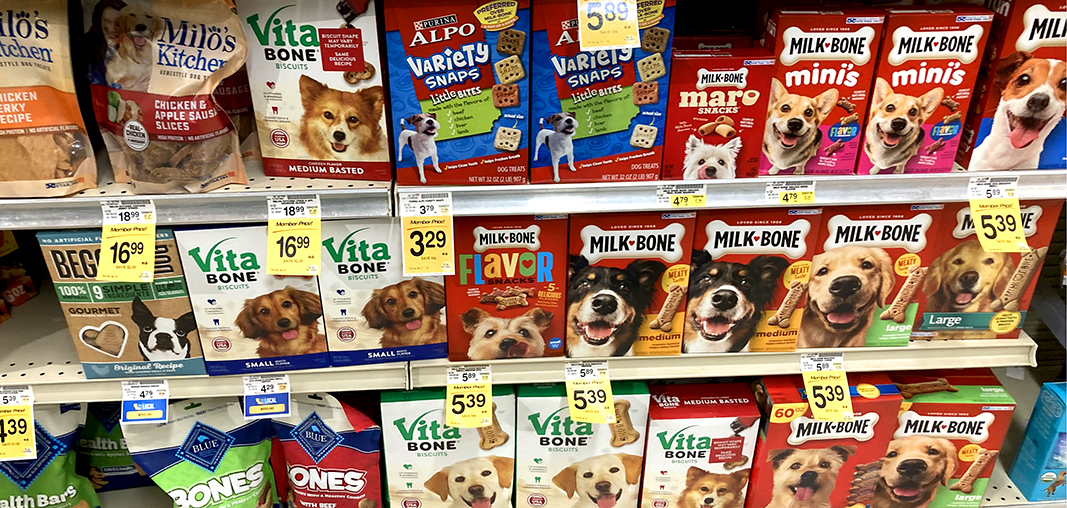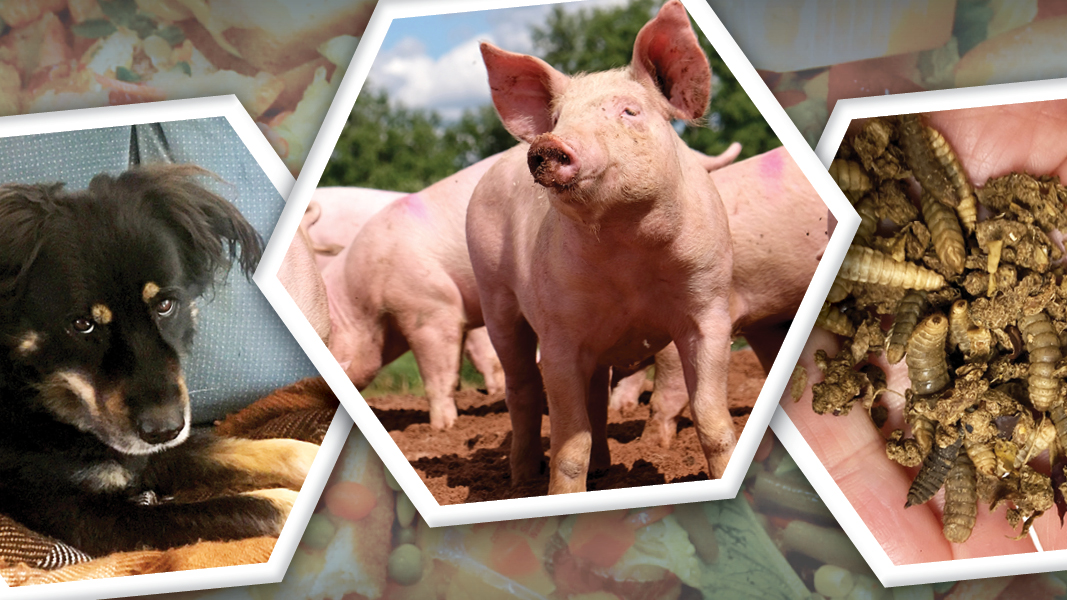Top: Images courtesy Sally Brown and kallerna, CC BY-SA 4.0, via Wikimedia Commons
 Sally Brown
Sally Brown
I hope that you all read Nora Goldstein’s article, “Why We Can’t Afford To Waste Food,” on the changes to the U.S. EPA’s food scraps analysis. It gives an excellent summary of the findings — that the food getting wasted also takes a lot of land, energy, and water to grow. The part of the revision that she didn’t dwell on is the upgrade for animals. Feeding these scraps to animals is now the next best thing to feeding them to people. Better than anaerobic digestion, better than composting and of course, better than landfilling. This provides an alternative route for the chili that you just can’t bear to look at one more meal time.
The question is which animals and how do we get these scraps to their bowls? The obvious answer is pigs. Two things come to mind. One of my mothers’ favorite sayings in German — talking about the parts of her family who weren’t the most discerning eaters — translates roughly as “They’re pigs. Feed them anything, they’ll eat it.” The second is that wonderful scene in Spirited Away, the classic animated film by Miyazaki. You can watch Shihiro’s parents turn to pigs as they gorge themselves at the free buffet.
Pigs are not particular about food scraps. They all apparently taste great to them. They can provide an excellent alternative to even the compost pile. New York City’s food waste was fed to swine in Secaucus, New Jersey from the late 19th century until the 1950s. In some parts of the world, this potential is part of the waste management hierarchy. One example that sticks with me is Cairo where waste management and pigs are the responsibility of the Christian minority. When swine flu hit many years ago, the government ordered all pigs to be slaughtered. Overnight the pigs were gone and the garbage began to pile up. A more successful example is Las Vegas (video link below). Here there is a pig farm just outside of town. The food scraps from the hotels are collected and fed to them. There is a great video clip about this and the pigs at the farm do bear a striking resemblance to Shihiros’ parents in the movie.
Is a hog farm on the edge of every city the answer? It might be in a city of the future. But for the U.S., raising pigs is a highly local activity. The farm in Las Vegas notwithstanding, the vast majority of pigs in the U.S. can be found in a handful of states. If you want to find pigs you need to travel to the Midwest or eastern North Carolina. The trend over time is for these operations to consolidate and grow, thus fewer pig farmers with higher numbers of pigs. There has been a 70% reduction in the number of pig farmers since 1990. In other words, if you have food scraps in Brooklyn, they would have to go a long distance to reach a hungry hog. While I am no expert on the palettes of pigs, it might be that during that journey your scraps would degrade enough for the pig to turn up his or her snout at the prospect of those scraps for supper.
Friendly Four Leggers
A solution then might be to identify a decentralized animal feeding operation where feeding food scraps instead of specially manufactured food would be an option. Look no further than Fido. Or Spot, or in my case Sophie. Your family dog is an alternative to Wilbur in North Carolina. You are much more likely to find a dog in a random home than you are a hog. About 57% of households have at least one pet and the majority of those are dogs. The pandemic has likely increased that number. Buying animal based, traditional food for your dog is a significant source of carbon emissions. A recent study used life cycle analysis to estimate the impacts of dog ownership. While impact will vary by pedigree, the average dog is responsible for over 8 tons of CO2eq emissions, largely as a result of their food. On a global level dogs consume about 20% of all of the meat and fish that is eaten. I will admit to giving Sophie sardines when she is a very good girl.

Feeding dogs leftovers is a guilt free way to make the dog happy and help the planet.
Feeding dogs leftovers is a guilt free way to make the dog happy and help the planet. Dogs are great at prewashing the dishes before you load them in the dishwasher. Those hardened pieces of cheese are delicious. The fatty or gristly parts of your chop are tender to them. We recently cleaned out the freezer and much of the mystery meat was relabeled “for Soph.” The extra fried potatoes, carrots and pancakes are appreciated rather than wasted. If you have any doubts about this, just remember other things that count as treats if you are a dog. Sadie (she preceded Sophie) had a fondness for horse poop, aged just enough that it was crunchy on the surface but still creamy in the middle. With that in mind, your old chili is an extravagance.

The average dog is responsible for over 8 tons of CO2eq emissions, largely as a result of their food.
The issue with this approach to food scraps is that there are many types of food that just don’t cut it for the majority of canines. Here I am thinking fruits and vegetables. A friend’s dog will beg for endive but most turn their nose at any kind of vegetable. Try feeding your furry friend some banana and I’ll bet you it doesn’t go so well. In this case we have an emerging option and a true means to really close the loop on a local level.
Fly Farming
Feed the food to bugs and then make those bugs into kibble for Fido. Insects are even less fussy about what they eat than pigs. That is conjecture on my part but likely not too far off from reality. They also do not require the same footprint to raise as pigs. Having a fly farm outside of every city is a lot more realistic than having a hog farm next to the commuter rail station. I’ve written about black soldier flies in this column as a great way to transform food waste or feces into a highly nutritious food source. It turns out that you can make dog food from bugs. Insect based animal food is available in Canada and much of Europe. These are typically cricket based but can also be made from soldier fly larvae and grubs. Right now, the FDA has only approved of dog treats that are insect based for canines in the U.S. That is likely poised to change in the near future.
In the U.S., right now, it is highly unlikely that the market for food waste for industrially raised animals will grow significantly. Commercial meat production is too systematized and too centralized. For food scraps to figure in as animal feed it makes sense to focus on animals that we need to feed to make them happy and wag their tails more. For many of us, that can start right away. If you don’t feed your dog table scraps, now is the time to start. Just do it away from the table. As the insect protein market is rapidly growing this might be the time to search out your local cricket farmer. In fact, animal feed from insects would likely make hogs as happy as it would puppies. Food scraps for Fido — directly when possible but with bugs as part of the food chain — offers the potential to satisfy your pooch as well as the revised EPA food scrap hierarchy. That would get me to wag my tail.
Sally Brown, BioCycle Senior Adviser, is a Research Professor in the College of the Environment at the University of Washington.













